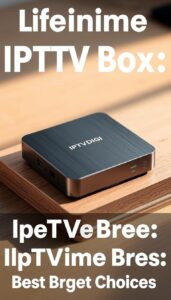Traditional cable and satellite TV services are rapidly giving way to more flexible, feature-rich alternatives. At the forefront of this revolution is IPTV, or Internet Protocol Television, which delivers television content over internet connections rather than through conventional broadcast methods. This comprehensive guide explores everything you need to know about IPTV technology, from how it works to its benefits, challenges, and future trends.
What Is IPTV? Understanding the Basics

IPTV delivers television content over internet connections to various devices
IPTV (Internet Protocol Television) refers to the delivery of television content over Internet Protocol (IP) networks. Unlike traditional broadcast, cable, or satellite TV, IPTV sends shows and movies through your internet connection. This technology transforms how we consume media by providing more interactive features and on-demand options than conventional television services.
The term “IPTV” first appeared in 1995, but the technology only gained significant traction in the 2000s alongside the rise of broadband internet. Today, it represents one of the fastest-growing segments of the entertainment industry, with millions of subscribers worldwide enjoying its flexibility and extensive content libraries.
Ready to Cut the Cord?
Discover how IPTV can save you money while offering more channels and features than traditional cable packages.Compare IPTV Services
How IPTV Works: The Technology Behind the Scenes

The technical infrastructure that powers IPTV services
IPTV works by converting traditional television signals into data packets that can be transmitted over IP networks. This process involves several key components working together seamlessly:
Content Acquisition and Processing
The journey begins with content acquisition. Television providers obtain programming from various sources, including live broadcasts, pre-recorded shows, and movies. This content is then processed through encoders that compress the video and audio into digital formats suitable for internet transmission, typically using protocols like H.264 or H.265 for video compression.
Content Delivery Networks
Once encoded, the content travels through Content Delivery Networks (CDNs) – distributed systems of servers designed to deliver media efficiently. CDNs ensure that content is stored closer to end-users, reducing latency and buffering issues that might otherwise affect streaming quality.
Streaming Protocols
IPTV relies on various streaming protocols to deliver content effectively. These include:
- Real-Time Transport Protocol (RTP) for live TV streaming
- Real-Time Streaming Protocol (RTSP) for controlling streaming sessions
- Hypertext Transfer Protocol (HTTP) for video-on-demand content
- Dynamic Adaptive Streaming over HTTP (DASH) for adaptive bitrate streaming
End-User Reception
At the user end, an internet connection receives these data packets. A compatible device – whether a smart TV, set-top box, computer, or mobile device – decodes the packets back into viewable content. The minimum recommended connection speed for standard definition IPTV is around 3-5 Mbps, while HD content typically requires 5-10 Mbps or higher.
Types of IPTV Services
Live Television (IPTV)
This is the direct equivalent of traditional broadcast TV, allowing viewers to watch programs in real-time as they’re broadcast. Sports events, news, and special live events typically use this format.
Video on Demand (VOD)
VOD services provide a library of content that users can access whenever they want. This includes movies, TV series, and other programming that viewers can start, pause, and resume at their convenience.
Time-Shifted Media
This format allows viewers to watch previously broadcast content at their convenience. Features like “catch-up TV” let users view shows they missed without having to record them in advance.
IPTV vs. Traditional TV: Key Differences

The fundamental differences between IPTV and traditional television delivery methods
IPTV Advantages
- On-demand content availability
- Multi-device compatibility
- Interactive features and personalization
- Typically lower cost than cable packages
- No geographical limitations (with proper setup)
- Higher content variety and international channels
- No need for satellite dishes or complex installations
IPTV Limitations
- Requires stable internet connection
- Potential for buffering during peak usage times
- Quality depends on internet speed
- Some services may have legal gray areas
- Can consume significant bandwidth
- May require technical knowledge to set up
- Potential for service interruptions during internet outages
Experiencing Buffering Issues?
Get our free guide to optimizing your home network for smooth, buffer-free IPTV streaming.Download Network Optimization Guide
Benefits of IPTV: Why Users Are Making the Switch

IPTV offers enhanced control and content selection compared to traditional TV services
Cost Efficiency
IPTV services typically offer more competitive pricing than traditional cable or satellite packages. With most providers, you pay only for the content you want, avoiding the bloated packages that characterize conventional TV subscriptions. Many services start at just $10-20 per month, compared to cable packages that often exceed $100 monthly.
Content Flexibility
With IPTV, viewers gain unprecedented control over what they watch and when they watch it. The combination of live channels and extensive on-demand libraries means you’re never limited to what’s currently broadcasting. Many services also offer catch-up features that let you view recently aired content without having to plan ahead or set recordings.
Device Compatibility
Unlike traditional TV services that require specific hardware, IPTV works across multiple devices. Whether you prefer watching on your smart TV, computer, tablet, or smartphone, you can access your content anywhere with an internet connection. This multi-device compatibility makes IPTV ideal for today’s on-the-go lifestyle.
Interactive Features
IPTV platforms often include interactive elements that traditional TV cannot match. These may include integrated program guides, content recommendations based on viewing habits, search functionality, and even social media integration. Some services also offer interactive advertising and shopping features.
Global Content Access
Geographic restrictions become less relevant with IPTV. Many services offer international channels and content that would be unavailable through local cable providers. This global reach is particularly valuable for expatriates or anyone interested in international programming, news, or sports.
Scalability
IPTV services can easily scale to meet your needs. Whether you want a basic package with a few channels or a comprehensive entertainment solution with hundreds of options, there’s likely an IPTV service that fits your requirements. This scalability extends to multiple household members who can often create individual profiles with personalized recommendations.
4.7
User Satisfaction
Content Variety
4.7/5
Cost Savings
4.8/5
Ease of Use
4.3/5
Streaming Quality
4.5/5
Device Compatibility
4.9/5
IPTV Hardware and Requirements: What You Need to Get Started

Essential hardware components for setting up an IPTV system
Internet Connection Requirements
A reliable internet connection is the foundation of any IPTV setup. Here are the recommended speeds based on content quality:
| Content Quality | Minimum Speed | Recommended Speed | Notes |
| Standard Definition (SD) | 3 Mbps | 5 Mbps | Suitable for basic viewing on smaller screens |
| High Definition (HD) | 5 Mbps | 10 Mbps | Recommended for most household viewing |
| 4K Ultra HD | 25 Mbps | 50+ Mbps | For premium viewing experience on large screens |
| Multiple Devices | 10+ Mbps per device | 100+ Mbps | For households streaming on several devices simultaneously |
Essential Hardware
- Internet Router: A modern router capable of handling streaming traffic, preferably with QoS (Quality of Service) features to prioritize streaming data
- Streaming Device: This could be a dedicated IPTV set-top box, a smart TV with built-in IPTV capabilities, or a streaming stick like Amazon Fire TV, Roku, or Apple TV
- Display Device: Any modern TV or monitor with HDMI input
- HDMI Cables: For connecting your streaming device to your display (if not using a smart TV or built-in solution)
Optional Enhancements
- Ethernet Cable: For a more stable connection than Wi-Fi, especially for 4K content
- Wi-Fi Extenders: To ensure strong signal throughout your home
- External Storage: Some IPTV boxes support recording functionality with external hard drives
- Universal Remote: To control multiple devices with one remote
- Sound System: For enhanced audio experience
Need Help Choosing the Right IPTV Hardware?
Our experts have tested dozens of IPTV-compatible devices to find the best options for every budget and need.View Recommended IPTV Hardware
Popular IPTV Services and Providers

User interfaces of popular legitimate IPTV services available today
The IPTV market includes a wide range of service providers, from major telecommunications companies to specialized streaming platforms. Here’s an overview of some legitimate IPTV options across different categories:
Premium Live TV Services
- YouTube TV: Offers 85+ channels including local networks, sports, and news
- Hulu + Live TV: Combines on-demand content with 75+ live channels
- Sling TV: Affordable option with customizable channel packages
- FuboTV: Sports-focused service with extensive international offerings
Telecom Provider IPTV
- AT&T TV: Comprehensive service with multiple package options
- Verizon Fios TV: High-quality service with fiber-optic delivery
- Bell Fibe TV: Canadian service with extensive channel lineup
- BT TV: UK-based service with flexible packages
Specialized & International
- DAZN: Sports-focused service available in multiple countries
- Peacock TV: NBCUniversal’s platform with both free and premium tiers
- BBC iPlayer: UK public service offering with catch-up features
- Hotstar: Popular in India with sports and entertainment content
Choosing the Right IPTV Service
When selecting an IPTV provider, consider these key factors:
- Content Library: Ensure the service offers the channels and on-demand content you’re interested in
- Streaming Quality: Check what resolution options are available (SD, HD, 4K)
- Device Compatibility: Verify that the service works with your preferred viewing devices
- Simultaneous Streams: Consider how many devices can stream at once if you have a larger household
- DVR Capabilities: Look for cloud DVR features if recording content is important to you
- User Interface: A clean, intuitive interface makes finding content easier
- Price and Contract Terms: Compare monthly costs and whether long-term commitments are required
- Customer Support: Good technical support is essential for resolving any issues
IPTV Setup Guide: Getting Started in 5 Steps

Follow these steps to set up your IPTV system quickly and efficientlyAssess Your Internet Connection
Before subscribing to any IPTV service, test your internet speed using online speed test tools. Ensure your connection meets the minimum requirements for your desired streaming quality. If necessary, upgrade your internet plan or optimize your home network.Choose Your Viewing Device
Decide which device you’ll use to watch IPTV. Options include:
- Smart TVs with built-in streaming capabilities
- Dedicated IPTV set-top boxes
- Streaming devices like Amazon Fire Stick, Roku, or Apple TV
- Computers, tablets, or smartphones
Select and Subscribe to an IPTV Service
Research legitimate IPTV providers that offer the content you want. Consider factors like channel selection, video quality, and price. Once you’ve chosen a service, complete the subscription process, which typically involves creating an account and selecting a payment plan.Download and Install the Required App
Most IPTV services provide dedicated apps for various platforms. Download the appropriate app for your device from the official app store or the provider’s website. Some services may require you to use third-party apps like VLC Media Player or IPTV Smarters.Configure and Test Your Setup
Launch the app and sign in with your subscription credentials. Configure any settings according to your preferences, such as stream quality and parental controls. Test different channels and content types to ensure everything works properly. If you encounter issues, consult the provider’s troubleshooting guide or contact customer support.
Pro Tip: For the best streaming experience, connect your viewing device directly to your router using an Ethernet cable whenever possible. This provides a more stable connection than Wi-Fi, especially for high-definition content.
Ready to Start Streaming?
Compare the top-rated legitimate IPTV services based on content selection, streaming quality, and value for money.Find the Best IPTV Service for You
Legal Considerations and Best Practices

Understanding the legal landscape of IPTV services is essential for responsible use
Navigating the Legal Landscape
The legality of IPTV services varies depending on the content they offer and how they obtain it. Here’s what you need to know:
Legal IPTV Services
- Licensed services that pay for distribution rights (YouTube TV, Hulu Live, etc.)
- Official broadcaster streaming platforms (BBC iPlayer, NBC Peacock)
- Telecom provider IPTV packages (AT&T TV, Verizon Fios TV)
- Subscription-based streaming services with proper licensing agreements
Potentially Problematic Services
- Services offering premium content at suspiciously low prices
- Providers with no clear information about content licensing
- “Fully loaded” devices pre-configured with unauthorized add-ons
- Services advertising “all channels for free” or similar claims
Important: Using unauthorized IPTV services that stream pirated content may expose you to legal risks, malware, and unreliable service. Always research providers thoroughly and choose legitimate services that respect copyright laws.
Best Practices for IPTV Users
- Research Before Subscribing: Verify that a service has proper licensing for the content it offers
- Read Terms of Service: Understand what you’re agreeing to when signing up
- Protect Your Personal Information: Use secure payment methods and be cautious about sharing personal details
- Keep Software Updated: Regularly update your streaming apps and devices to protect against security vulnerabilities
- Use Strong Passwords: Protect your subscription accounts with unique, strong passwords
- Consider Privacy Measures: Some users opt to use VPN services for additional privacy when streaming
Troubleshooting Common IPTV Issues

Solutions for the most common IPTV streaming problems
How do I fix buffering issues?
Buffering is one of the most common IPTV problems and usually relates to internet speed or network congestion. Try these solutions:
- Restart your router and streaming device
- Connect via Ethernet instead of Wi-Fi if possible
- Close other applications or devices using your network
- Reduce the streaming quality in your IPTV app settings
- Check if your ISP is throttling streaming traffic (a VPN might help)
- Upgrade your internet plan if consistently experiencing issues
What should I do if channels won’t load?
If specific channels or content won’t load, try these troubleshooting steps:
- Check if the issue affects all channels or just specific ones
- Verify your subscription status and ensure it’s active
- Clear the app’s cache or data
- Reinstall the IPTV application
- Contact your service provider to check for known outages
How can I improve video quality?
If you’re experiencing poor video quality, consider these adjustments:
- Check your internet speed using online speed test tools
- Ensure your device meets the minimum requirements for HD streaming
- Adjust video quality settings in your IPTV app
- Reduce the number of devices using your network simultaneously
- Try a different HDMI cable or port if using an external device
- Update your streaming device’s firmware and IPTV app
What if my IPTV app keeps crashing?
App stability issues can be frustrating but are often fixable:
- Update the app to the latest version
- Clear the app’s cache and data
- Restart your streaming device
- Check if your device has sufficient storage space
- Uninstall and reinstall the application
- Try an alternative IPTV app that’s compatible with your service
Still Having IPTV Problems?
Get our comprehensive troubleshooting guide with step-by-step solutions for every common IPTV issue.Download Troubleshooting Guide
The Future of IPTV: Emerging Trends and Technologies

Next-generation IPTV technologies that will shape the future of television
The IPTV landscape continues to evolve rapidly, with several exciting developments on the horizon. Here’s what to expect in the coming years:
AI-Powered Personalization
Artificial intelligence and machine learning algorithms are revolutionizing content discovery. Future IPTV platforms will offer increasingly sophisticated recommendations based on viewing habits, preferences, and even mood detection. AI will also enable more natural voice control interfaces and smart content categorization that goes beyond traditional genres.
Enhanced Video Quality
As internet speeds continue to increase, expect IPTV services to offer more 4K and even 8K content. Advanced video codecs like H.266/VVC (Versatile Video Coding) promise to reduce bandwidth requirements by up to 50% compared to current standards, making ultra-high-definition streaming more accessible even without gigabit connections.
Interactive and Immersive Experiences
The line between passive viewing and interactive entertainment will continue to blur. Look for more IPTV services to incorporate interactive elements like multiple camera angles for sports, in-program purchasing options, and even augmented reality (AR) and virtual reality (VR) components that transform how we engage with television content.
5G Integration
The rollout of 5G networks will dramatically impact IPTV, particularly for mobile viewing. With speeds potentially reaching 10 Gbps and significantly reduced latency, 5G will enable high-quality streaming on mobile devices without Wi-Fi, potentially creating new categories of “on-the-go” IPTV services and changing how content is consumed outside the home.
Blockchain and Decentralized Platforms
Blockchain technology may transform content distribution and monetization in the IPTV space. Decentralized platforms could enable direct creator-to-viewer relationships, micropayments for content, and new copyright protection mechanisms. This could lead to more diverse content offerings and fairer compensation models for creators.
Integration with Smart Home Ecosystems
IPTV services will become more deeply integrated with broader smart home ecosystems. Imagine scenarios where your lights automatically dim when you start a movie, or your viewing automatically pauses when your doorbell rings. Cross-device synchronization will also improve, allowing seamless transitions between viewing on different screens.
“The future of television isn’t just about what we watch, but how we watch it. IPTV technology is transforming passive viewers into active participants in an increasingly personalized and interactive media landscape.”
— Media Technology Analyst
Conclusion: Is IPTV Right for You?

IPTV offers flexible viewing options for modern households
Internet Protocol Television represents a significant evolution in how we consume video content. With its flexibility, extensive content libraries, and interactive features, IPTV offers compelling advantages over traditional television services for many viewers.
As we’ve explored throughout this guide, IPTV technology delivers television content over internet connections rather than through conventional broadcast methods, enabling on-demand viewing, multi-device compatibility, and often more competitive pricing than cable or satellite alternatives.
IPTV is particularly well-suited for:
- Cord-cutters looking to reduce monthly entertainment expenses
- Tech-savvy viewers who value flexibility and control over their content
- Households with diverse viewing preferences that aren’t well-served by standard cable packages
- International audiences seeking content from their home countries
- Sports enthusiasts who want access to games and events not available through local broadcasts
While IPTV does require a reliable internet connection and some technical setup, the barriers to entry have decreased significantly in recent years. User-friendly interfaces, plug-and-play devices, and improving internet infrastructure have made IPTV accessible to a broader audience than ever before.
As the technology continues to evolve with AI-powered recommendations, higher resolution options, and deeper integration with other smart home systems, IPTV is positioned to become the dominant form of television consumption in the coming years.
Whether you’re considering making the switch from traditional cable or looking to enhance your existing streaming setup, IPTV offers a flexible, feature-rich approach to television that aligns with how people want to consume content in today’s connected world.
Ready to Experience the Future of Television?
Compare top-rated IPTV services and find the perfect plan for your viewing habits and budget.Explore IPTV Options Today





